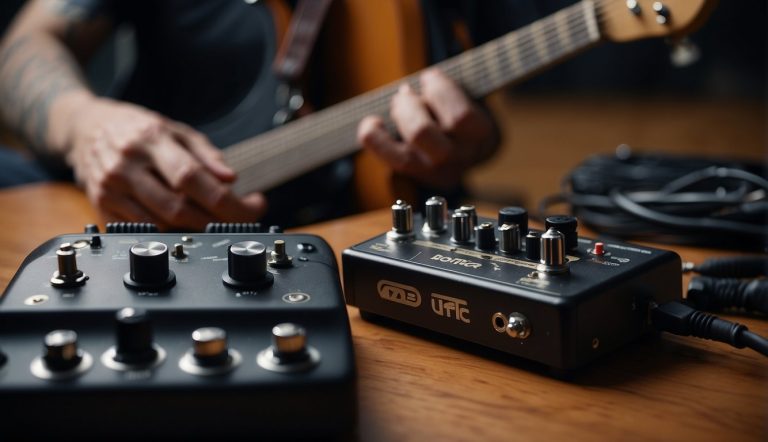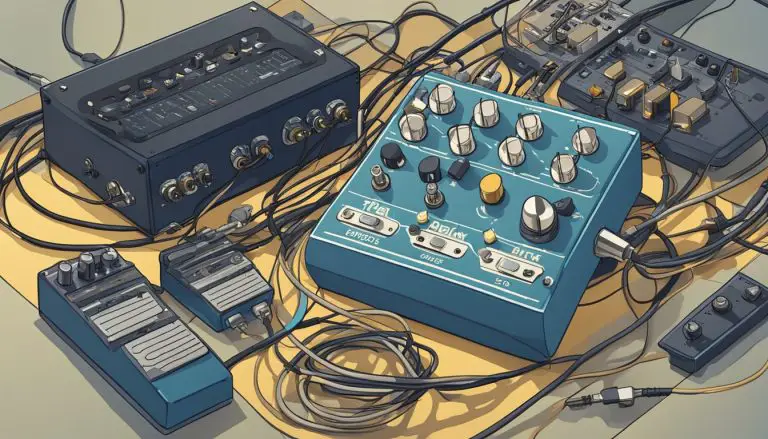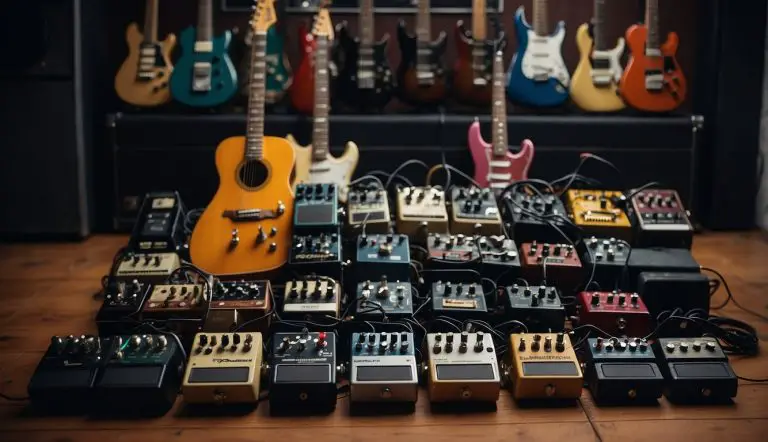How to Choose a Delay Pedal: Your Friendly Guide to Finding the Perfect Echo

Check out more: Top 3 Best Delay Pedal Reviews and Buying Guide
Selecting a delay pedal that aligns with your musical preferences and needs can significantly enhance your sound.
When I choose a delay pedal, my goal is often to add depth and dimension to my music.
Delay pedals repeat the notes or chords played on a guitar, allowing for a rich layering effect that can vary in duration and intensity.
Many musicians appreciate delay pedals for their ability to create an echoing effect that can be subtle background or a pronounced sonic feature.

To find the right delay pedal, I take into account the different types of delays available— digital, analog, and tape delays— all of which offer distinctive tonal qualities.
Digital delays tend to provide crisp and precise repeats, while analog delays give a warmer and softer echo.
Tape delays are known for their vintage charm, emulating the sound of old magnetic tape units.
Understanding the specifics of these types, such as maximum delay time, the option for tap tempo, number of presets, and true bypass versus buffered bypass, is crucial for making an informed decision.
Key Points
- Identifying personal musical needs is crucial for selecting the ideal delay pedal.
- Understanding the distinct sound qualities of digital, analog, and tape delays helps in making a choice.
- Consideration of delay pedal features, including delay time and bypass options, is key to finding the right pedal.
Table of Contents
Understanding Delay Pedals
When I’m choosing a delay pedal, I prioritize understanding the difference between analog and digital delays, the variety of delay effects available, and the unique qualities of tape delay emulation.
Analog vs. Digital Delays
Analog delay pedals, like the classic Boss DM-2, use bucket-brigade devices (BBDs) to create warm, natural-sounding repeats which often degrade in fidelity with each subsequent echo.
They typically have a shorter delay time, up to 600ms.
In contrast, digital delay pedals, such as the TC Electronic Flashback, use digital signal processing (DSP) to replicate sounds and produce precise, pristine echoes.
They offer longer delay times and more features, including tap tempo and presets.
Different Types of Delay Effects
Delay pedals come with a variety of effect types:
- Slapback Delay: A single, short echo, historically used in rockabilly and country music.
- Modulated Delay: Adds modulation like chorus or vibrato to the repeats for a richer sound.
- Reverse Delay: Plays the delay line in reverse, creating a psychedelic effect.
- Multi-Tap Delay: Offers multiple repeats at specific intervals, useful for creating rhythmical patterns.
Tape Delay Emulation and its Significance
Tape delay emulation pedals, such as the Strymon El Capistan, mimic the sound characteristics of vintage tape echo machines like the Maestro Echoplex.
They are revered for their warm, saturated repeats and the characteristic flutter and wow effects.
These pedals often combine the analog warmth with the convenience of digital control, making them a significant and sought-after type of delay pedal in my setup.
Key Features to Consider When Choosing a Delay Pedal
When I’m in the market for a delay pedal, there are several key features I pay close attention to, since they deeply impact my playing style and the sounds I can create.
Delay Time and Feedback Control
Delay time is crucial as it determines the maximum duration between my repeated notes.
Pedals range significantly in this aspect, with times from 20ms up to several seconds.
I also look for feedback control since it allows me to set the number of repeats.
It’s essential for crafting those lush, ambient landscapes or just adding a simple echo to my sound.
Tap Tempo and Looper Functions
Having a tap tempo feature is a game-changer because it lets me easily sync my delay time with the song’s tempo in real-time, just by tapping a button.
In addition, a looper function is incredibly handy if I want to layer parts or practice complex pieces; it essentially turns the pedal into a multi-functional tool.
Extra Effects: Modulation, Pitch-Shifting, and More
I love when a delay pedal includes extra effects like modulation, which can add a chorus or flanger-like quality to the repeats, enriching the texture.
Furthermore, pitch-shifting can create harmonies and take my creativity to new heights.
I always look for these to ensure my pedal can offer more than just standard delay sounds.
Top Picks by Genre and Playing Style
When I’m choosing a delay pedal, I consider how it complements my playing style and the genre I’m targeting.
Specific effects can enhance solos or create lush ambient soundscapes, so let’s explore some top picks.
The Best Delays for Solos and Riffs
For solos and sharp-defined riffs, I prefer pedals that offer a crisp repeat with fine control over the delay time.
The Boss DD-3T is a great choice, featuring precise delay adjustments that work brilliantly for lead guitarists.
A setting around 300-500 milliseconds works well for solos, allowing each note to stand out without muddying the overall sound.
Creating Ambient Soundscapes
To craft ambient soundscapes, I look for delays with expansive settings and the ability to layer sounds.
The Strymon Timeline is my go-to here.
It provides a multitude of delay types and has a lush reverb that can be added to the delayed signal, allowing for an immersive atmospheric experience, essential for ambient players.
Delays Tailored for Different Music Genres
Different music genres necessitate different delay approaches:
- For rock and metal genres, where powerful riffs are key, a pedal like the MXR Carbon Copy offers a warm analog delay that complements aggressive playing without overwhelming the mix.
- For country or blues, I might lean towards a pedal with a slap-back delay, such as the TC Electronic Flashback, enabling those short, snappy echo effects that enhance twangy licks.
- In electronic music or experimental genres, where unique sound-shaping is essential, the Eventide TimeFactor with its range of customizable presets and complex rhythms fits perfectly.
Making the Right Choice: Buying Guide and Reviews
When shopping for a delay pedal, I always start by setting a budget.
It’s important to know how much I’m willing to spend, as options range widely in price.
I then read reviews to gauge user satisfaction and pedal performance.
Reviews can provide insights into the reliability and the sound quality of the pedal, which is critical to my decision-making process.
My top picks are often those that receive consistent praise for durability and clarity of the delay effect.
In reviews, I look for mentions of the pedal’s features such as tap tempo, different types of delay modes, and true bypass, as these can greatly affect my playing experience.
I also pay attention to details like:
- Maximum delay time: This dictates how long the echo effect will be.
- Type of delay: Analog delays have a warmer tone, while digital delays offer more precision and versatility.
- Ease of use: A simple user interface is always a plus for me.
Here’s a concise table summarizing key aspects to consider:
| Feature | Why It Matters |
|---|---|
| Budget | Keeps me from overspending and narrows my options. |
| Reviews | Offers firsthand experiences and insights. |
| Durability | Ensures I won’t have to replace the pedal anytime soon. |
| True bypass | Maintains my tone when the pedal is off. |
| Delay modes | Provides versatility in the sounds I can create. |
Frequently Asked Questions
When scouting for the perfect delay pedal, it’s essential to factor in various features that align with your musical needs and personal style.
What features should I consider when choosing a delay pedal for my guitar?
I always consider the type of delay effects on offer, such as digital, analog, and tape emulations.
I also look at the maximum delay time, the quality of sound, the pedal’s true bypass, tap tempo functionality, and whether it has stereo inputs and outputs.
How can I determine the best delay pedal for achieving a slapback echo effect?
For a crisp slapback echo, I seek out a delay pedal that can produce short delay times with a single echo repetition.
A pedal that lets me fine-tune the delay time between 80 to 160 milliseconds without many repeats is ideal for this effect.
Can you suggest a good delay pedal that provides a tape delay sound?
I’ve found that pedals like the Strymon El Capistan offer an excellent tape delay emulation, providing warm, saturated sounds reminiscent of vintage tape echo units. It’s one of my go-to options for that classic sound.
What are the advantages of analog versus digital delay pedals?
An analog delay pedal like the MXR Carbon Copy gives me a warmer, natural sounding echo that degrades with each repeat, while a digital delay like the Boss DD-7 offers crisp, precise echoes and usually more features and longer delay times.
What are some top delay pedals that professionals use for guitar solos?
Many professional guitarists use delay pedals such as the TC Electronic Flashback 2 or the Eventide TimeFactor, known for their versatility and high-quality sound that can enhance solos with deep, rich delays.
How do I choose a quality delay pedal on a budget?
I look for delay pedals that offer the core features I need without the extra frills.
Brands like Donner and Behringer have reliable delay pedals that won’t break the bank.
For example, the Donner Yellow Fall and the Behringer VD400 provide solid performance at an affordable price.





